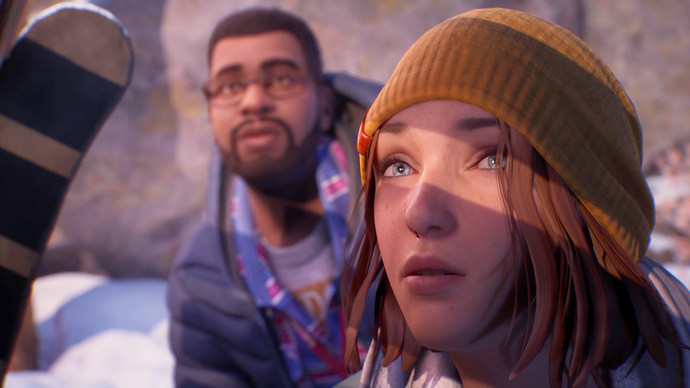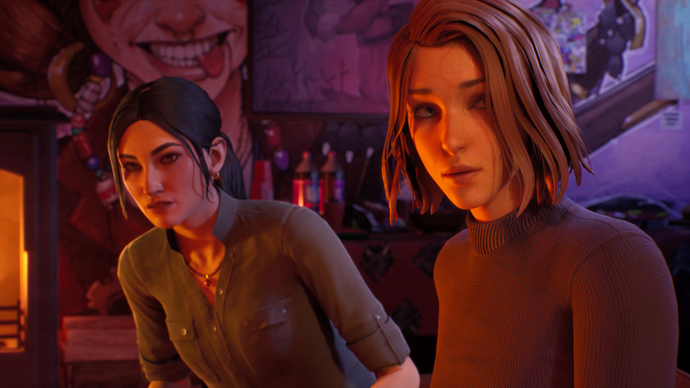Like its own hero’s dabbling with time travel, Life is Strange: Double Exposure highlights the troubles of trying to revisit old memories, while raising unanswered questions about the future.
Towards the end of Life is Strange: Double Exposure, protagonist Max Caulfield insists she will not accept another impossible choice “between two shitty options”. She’s referencing, of course, the original Life is Strange‘s climactic dilemma, where players were forced to choose whether Max sacrificed her hometown or her closest ally. It’s a moment that has reverberated through every Life is Strange game since, and has come to define a series centred around young adult drama and living with the consequences of your actions. Max’s declaration she won’t pick again between two similar no-win scenarios is meant to feel triumphant: she has experienced that trauma once, and is now older, bolder and wiser, so will instead fight to forge a third path. It makes for a heroic scene, and raises expectations for the game’s ultimately rather maddening climax. But it simultaneously also glosses over the reality of that original, heartbreaking decision: that its impossible nature was the point.
Regardless of the option picked, Life is Strange forced players to reflect on the connections they had forged with its cast of characters – most notably, the charismatic fan-favourite Chloe, with whom Max could begin a relationship – to find a personal resolution that balanced emotion and cold logic. The result? An ending that cemented that game in memory, sparked years of fan discussions and debate, and reflected one of the hardest lessons of adolescence: that sometimes there is no correct way forward.
Fast forward almost a full decade, and Life is Strange: Double Exposure picks up the story of Max Caulfield with a similar desire by the game’s developer Deck Nine to forge a fresh path, effectively appealing to the nostalgia of loyal and long-term fans by returning to the franchise’s beloved original hero, but playing down the effects of that original choice in order to do so. Double Exposure does its best to unite the original game’s two endings (whichever you choose, Chloe is referenced but never physically present) in order to tell a fresh story, juggling the question of what Max did next with the need to propel the entire Life is Strange franchise forward to some surprising and refreshing new ground.
Step up Safi, Max’s new best friend and teaching colleague at Caledon University, whose presence lifts every scene she’s in. Double Exposure’s opening episode gives Safi just enough screen time to cement her burgeoning bond with Max (purely platonic, this time around) before her murder properly kickstarts Life is Strange’s familiar blend of mystery and investigative gameplay via magic powers. Safi’s subsequent absence is keenly felt – a testament to the character’s introduction – while Max’s discovery she can travel to a parallel world in which Safi is still alive – for now, at least – only pushes the game’s stakes higher. Max must seemingly now investigate Safi’s murder in one timeline, while actively trying to prevent it happening in another. Much of Safi’s story is too wrapped in spoilers for discussion here, but suffice to say her characterisation – a fierce and fearless mix of Marvel’s Agatha Harkness and Faith from Buffy – and her performance by newcomer Olivia AbiAssi is genuinely a joy to witness. (A shout out here to Deck Nine’s excellent character animation, which stands up alongside PlayStation and Xbox first-party blockbusters.) After finishing Double Exposure, I’ve gone back simply to rewatch some of the key scenes between Safi and Max (once again played effortlessly by the returning Hannah Telle) which are, by some measure, the game’s highlights.
As Caledon University’s “photographer-in-residence”, Max’s role is vague enough that you have freedom to investigate Safi’s murder across both timelines, and quickly uncover a web of schemes, rivalries and unrequited loves across the campus, with secrets and side-stories to discover among both students and faculty. Max has help in her investigations from her friend Moses – a stoic and understated character who nevertheless provides some real warmth – and university barkeeper Amanda, whose sweet chemistry with Max can extend beyond mixing drinks.
Not every character feels as well-rounded, alas. Vinh, the slimy principal’s assistant and head of the campus’ frat-like Abraxas Society, is particularly uneven. His writing and portrayal veer uncomfortably between lecherous and contrite over elements of his past. Later attempts to soften his personality still left me with the ick, and the bizarre decision to make him an alternative romance option for Max never comes close to landing. Alderman, a detective briefly investigating Safi’s murder, feels a cliched inclusion designed to offer an early-game antagonist, before he disappears and is never mentioned again. I also felt frequently perplexed by the game’s treatment of Yasmin, Safi’s mother and Caledon’s principal. In the timeline where Safi is alive, mother and daughter share too few scenes to explore what is a key relationship, while in the world where her daughter is dead, the game has Max inexplicably ignore messages from her, and Yasmin return to posting on social media about school affairs just a couple of days after the trauma of her daughter’s murder. There are several other examples where the game’s tone just feels off, in particular during its early hours where the timeline in which Safi lives is still to be established. Despite her friend’s death, Max will still chirpily comment on her environment or crack jokes when examining objects.

And then there’s Chloe. When I wrote about Double Exposure’s “advanced access” release a couple of weeks ago, I highlighted the nonsensical and grubby-feeling decision to release the game’s first two chapters early to those who forked out for the privilege. (These fans also get a few interactions in the full game between Max and a pet cat that those who don’t pay extra will miss – another bizarre example of how this project’s release feels nickel-and-dimed.) In practice, though, the main response to Double Exposure’s early chapters was a monumental wave of displeasure from some of Life is Strange’s most passionate followers at its handling of the franchise’s fan-favourite blue-haired girl.
Those who chose to save Chloe in the original game – and in particular, those who still fervently believe she and Max should be a couple, seemingly, forever – revolted at Double Exposure’s immediate reveal that Chloe’s absence, if alive, is down to the fact the pair have split. I’ve watched the backlash continue to unfurl over the past weeks and been surprised to see the extent it has spread across the fandom – enough to provoke convincing-looking anonymous responses from former Double Exposure staff with excuses for why it was all handled this way, as well as pointed posts on social media suggesting displeasure by members of Life is Strange’s original development team, before the series’ original director finally waded in to call for calm.
To me, Max and Chloe breaking up is wholly believable. A decade with your teenage sweetheart is a long time, and that’s without the myriad additional pressures of accepting a partner with special powers who sacrificed a town-full of lives (including your own mum). Chloe is still repeatedly mentioned, and Max isn’t forced to romance anyone else. There’s little room for Chloe in this story – and there are good reasons other than nostalgia and fan familiarity for why a solo return to Max is interesting. Still, could this inevitable reaction have been handled better by the game, had the desire seemingly been there? Sure.

Double Exposure’s second half is stronger, and even those who played its early chapters may be surprised where its story ends up. (Though perhaps not – as I write this, I’m watching another consequence of the game’s “advanced access”: datamined audio from the final episode being made public.) Without spoiling anything here, it’s fair to say there’s more going on in Double Exposure than initially meets the eye – enough that I’ve been compelled to replay certain moments after a key reveal – and the game’s penultimate chapter, in particular, rockets along. It’s here, finally, we see Max sit down and reflect on her powers in a conversation unlike any other in the series so far, setting in motion story elements wider than just this game.
As someone who adored the original Life is Strange and stuck with the series ever since, I have to admit a real joy to checking back in on Max all these years later, to feel and hear the similarity in the character – but also see the natural changes in her as she’s grown in the interim. There’s plenty for Max to get to grips with here, and what initially feels like an intriguing endgame choice to make. If Double Exposure begins feeling too familiar to the original Life is Strange (Max in a school-like setting dealing with creepy teachers, a dead friend, and a longer-dead friend-of-theirs), its latter half surprisingly brings back echoes of Don’t Nod’s less-beloved Life is Strange 2, and the complexities of dealing with a situation your own abilities feel unable to control.
Double Exposure ends with what can only be described as a bold direction for the future of the franchise, one that’s certainly going to spark debate, but one which also comes at the cost of a fuller conclusion now. That ending choice is ripe to reverberate further – but its ripples remain frustratingly unseen. It’s yet another odd narrative decision from developer Deck Nine – and one that’s only made more conflicting by in light of a report this year that highlighted the company’s internal storytelling struggles, including the departure of a key creative, troubling intervention by publisher Square Enix, and its seeming inability to expel an employee inserting fascist imagery into its files.
Life is Strange still holds an important place in many fans’ hearts – if nothing else, the past weeks’ backlash proves that. But despite Double Exposure’s finer moments and startling vision to move the series forward, what’s here now doesn’t feel as assured a step as I’d have liked. While visually polished, there’s one too many narrative rough edges and not enough resolution when all is said and done. I’m still keen to see what happens next, particularly how Double Exposure’s ending is received and discussed by fans over the coming months and years, and whether the impact of Max’s first outing – which resonated so strongly, and for so long – can ever be repeated here or elsewhere down the line. Continuing Life is Strange has never been straightforward, but then, sometimes there is no correct choice to make.
A copy of Life is Strange: Double Exposure was provided for review by Square Enix.
